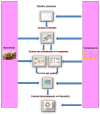Can Buckwheat Affect Health and Female Reproductive Functions?
- PMID: 39903885
- PMCID: PMC11835214
- DOI: 10.33549/physiolres.935379
Can Buckwheat Affect Health and Female Reproductive Functions?
Abstract
The aim of the present narrative review is to summarise the existing knowledge concerning physiological and reproductive effects of buckwheat, its mechanisms of action on various targets, as well as outlines the direction of the further studies of this functional food plant. Search for literature was performed in agreement with the PRISMA criteria in Cochrane Library, Pubmed, Web of Science, SCOPUS databases between the year 1995 and 2023. Words used to search were buckwheat, review, fertility, ovarian and mechanisms. The current review of the available literature demonstrates the high nutritional value of buckwheat, as well as high contents and number of regulatory molecules in this functional food plant. These molecules can, via multiple signalling pathways, affect a wide spectrum of physiological processes and illnesses, which suggests a therapeutic value of buckwheat substances. Furthermore, recent reports demonstrate ability of buckwheat extract to directly affect basic ovarian cell functions (proliferation, apoptosis, viability, steroidogenesis). On the other hand, understanding the character and applicability of buckwheat influence on female reproductive processes requires further studies. Keywords: Buckwheat, Nutrition, Health, Ovary, Signalling.
Conflict of interest statement
Figures
Similar articles
-
Effects of benzene on gilts ovarian cell functions alone and in combination with buckwheat, rooibos, and vitex.Environ Sci Pollut Res Int. 2021 Jan;28(3):3434-3444. doi: 10.1007/s11356-020-10739-7. Epub 2020 Sep 11. Environ Sci Pollut Res Int. 2021. PMID: 32915450
-
Effects, Mechanisms of Action and Application of Vitex agnus-castus for Improvement of Health and Female Reproduction.Phytother Res. 2025 Mar;39(3):1484-1493. doi: 10.1002/ptr.8438. Epub 2025 Jan 24. Phytother Res. 2025. PMID: 39853839 Review.
-
Buckwheat, rooibos, and vitex extracts can mitigate adverse effects of xylene on ovarian cells in vitro.Environ Sci Pollut Res Int. 2021 Feb;28(6):7431-7439. doi: 10.1007/s11356-020-11082-7. Epub 2020 Oct 8. Environ Sci Pollut Res Int. 2021. PMID: 33033927
-
Rooibos (Aspalathus linearis) influence on health and ovarian functions.J Anim Physiol Anim Nutr (Berl). 2022 Sep;106(5):995-999. doi: 10.1111/jpn.13624. Epub 2021 Aug 16. J Anim Physiol Anim Nutr (Berl). 2022. PMID: 34402103 Review.
-
Buckwheat as a Functional Food and Its Effects on Health.J Agric Food Chem. 2015 Sep 16;63(36):7896-913. doi: 10.1021/acs.jafc.5b02498. Epub 2015 Sep 3. J Agric Food Chem. 2015. PMID: 26270637 Review.

